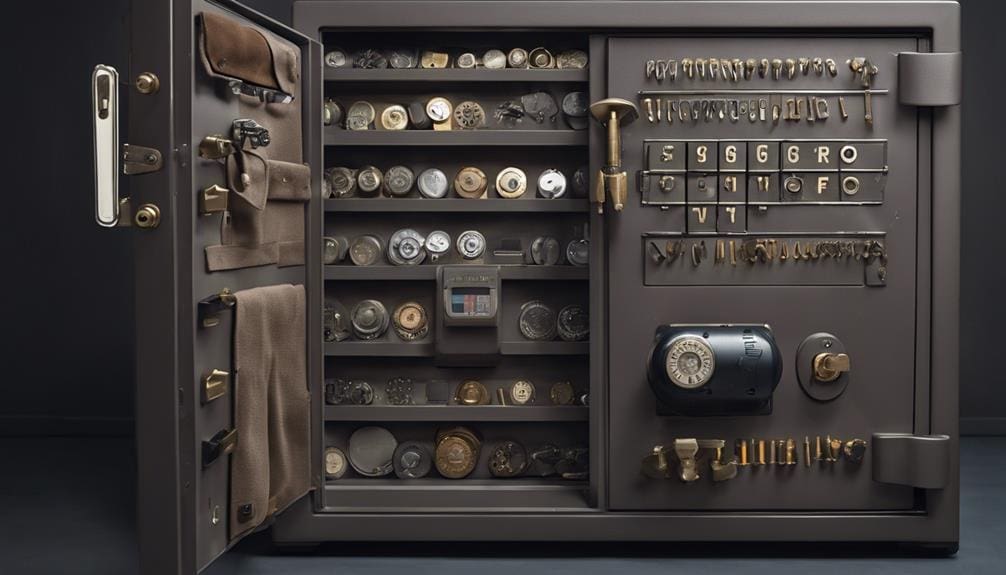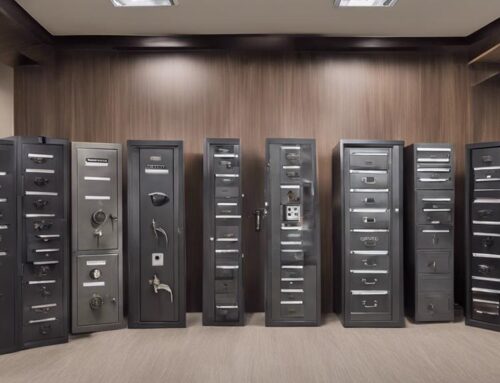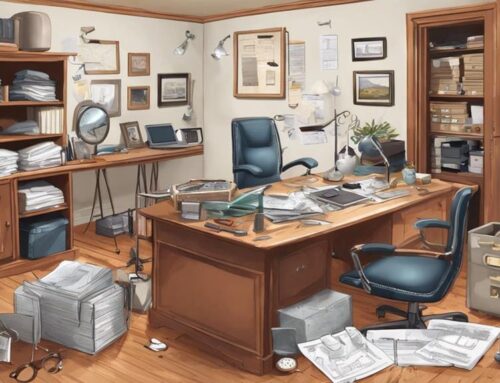To properly open gun safes, start with understanding your safe’s locking mechanism—keyed, combination, digital, or biometric. For new safes, follow manufacturer instructions closely. In case of safe lockouts, try manipulating the lock with specialized tools, but avoid force to prevent damage. If necessary, drilling or prying may work, but this demands precision to avoid compromising the safe. Always wear protective gear during such tasks. Regular maintenance every five years, keeping backup keys, and consulting professionals for tricky lockouts ensure safety and functionality. Learn more about mastering these techniques and preventive measures ahead.
Key Takeaways
- Choose the Right Locking Mechanism: Select a locking method that balances security and ease of access, such as digital or biometric locks.
- Consult a Professional Locksmith: For lockouts or maintenance, hire a licensed locksmith to ensure safe and damage-free access.
- Maintain Regular Maintenance: Schedule maintenance every five years to check all components and prevent unexpected lockouts.
- Store Backup Access: Keep a secure record of the combination and a backup key in a separate, secure location.
- Use Proper Techniques: Avoid damage by using correct methods like strategic prying, careful drilling, or using an angle grinder with protective gear.
Understanding Gun Safe Locks
When it comes to understanding gun safe mechanisms, recognizing the differences between key mechanisms, combination mechanisms, digital mechanisms, and biometric mechanisms is essential. Gun safe mechanisms vary in locking methods and vulnerabilities, so knowing each type helps you open a safe efficiently and securely.
Keyed mechanisms are straightforward; you insert a key to open. However, they’re susceptible to lock picking, making them less secure. For opening a safe with keyed mechanisms, make sure you keep the key in a secure place to prevent unauthorized access.
Combination mechanisms use a sequence of numbers to open. To access a safe with this type, you’ll need to turn the dial in a specific order. These mechanisms don’t rely on power sources, making them reliable but slower to access.
Digital mechanisms require a keypad and a code. Opening a safe with digital mechanisms involves entering the correct code. They’re quick and convenient, but they need batteries, which can die unexpectedly.
Biometric mechanisms use fingerprint scanners for access. They’re fast and secure, but fingerprints must be consistently read correctly. Accessing a safe with biometric mechanisms means ensuring your fingerprint is clean and properly registered.
Understanding these locking methods helps you choose the right gun safe mechanisms and secures your valuables effectively.
Manipulating Gun Safes
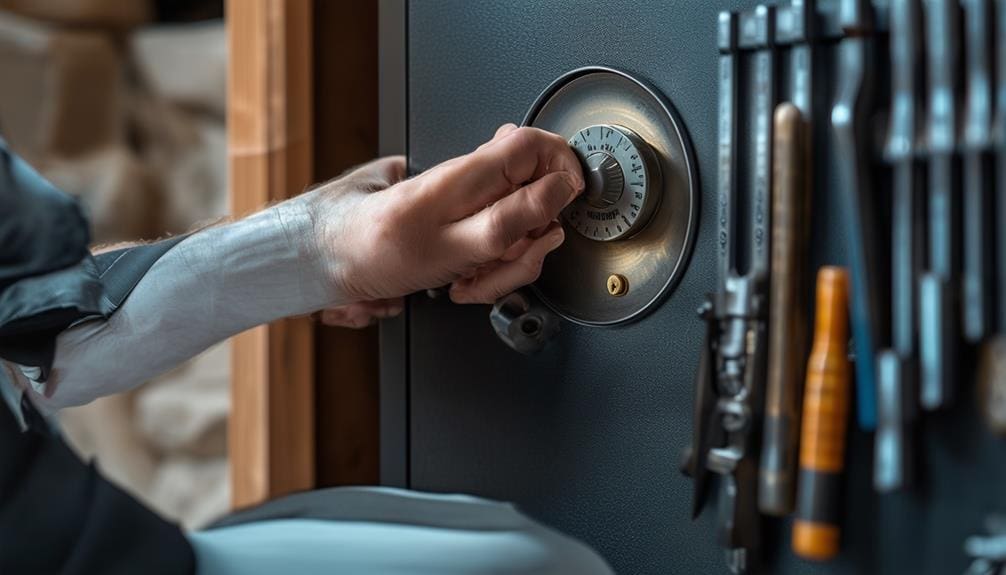
Manipulating gun safes without the correct keys or combinations requires specialized skills and a thorough understanding of the locking mechanisms involved. First, let’s discuss combination dials. These are more common than keypad combinations on gun safes. To manipulate a combination dial, you need specialized training to feel and listen for the subtle clicks that indicate the correct numbers. This non-deductive approach involves rotating the dial slowly and methodically, noting the resistance or sound changes.
For gun safes with a keyed lock, you’ll need to know how to pick locks. This involves using tools like tension wrenches and pick sets. Insert the tension wrench into the keyhole, apply slight pressure, and use the pick to lift the pins inside the lock one by one.
A key consideration is avoiding damage during manipulation. Damage to the safe lock can render the safe inoperable and make future manipulations ineffective. If you’re unsure, consult a locksmith who has the expertise and tools to handle safe lockouts without causing harm.
For those interested in mastering these techniques, seek specialized training and practice under expert supervision. These expert tips will help you open gun safes efficiently and safely.
Drilling Techniques
Before you start drilling, make sure you have a thorough understanding of the lock hardware to avoid unnecessary damage. Accurately locate the lock actuator to create an effective entry point for accessing the lock mechanism. Remember, drilling can leave marks indicating tampering, but a professional locksmith can often repair the damage.
Lock Hardware Knowledge
To effectively drill a gun safe, you need an in-depth understanding of the lock hardware and its components. Start by familiarizing yourself with the internal lock mechanism. Knowing these parts will help you choose the right drilling technique and minimize harm.
A locksmith typically drills a gun safe to gain access when keys or combinations are missing. This process begins by identifying the lock hardware. Study the lock’s components, such as the locking bolts, relocker, and the hard plate. Understanding these will guide your drilling approach.
Begin by selecting the appropriate drill bit based on the lock’s materials. Make sure you have the tools to create repairable harm. The goal is to pierce the hard plate without causing irreversible damage.
During drilling, be mindful that this process will leave visible marks, indicative of tampering or forced entry. Precision and care are essential to avoid excessive harm. A skilled locksmith can repair the drilled area, but signs of entry will remain.
Drilling Entry Point
Selecting the correct drilling entry point is necessary for accessing the lock mechanism effectively without causing unnecessary damage. First, you need to understand the lock hardware and its specific location within the safe. This involves identifying the precise spot where the lock actuator is situated, as hitting this component is important for a successful drilling process.
Begin by marking the entry point carefully. Use a high-quality drill bit designed for metal to penetrate the safe’s surface. Drilling should be done at a controlled speed to avoid excessive heat, which may damage the lock hardware. Consistent pressure is crucial to make sure a clean entry.
As you drill, maintain awareness of the angle and depth to avoid misalignment, which could lead to further complications or visible marks indicating tampering. Once you’ve reached the lock actuator, you can manipulate it to open the safe.
Repairing Drill Damage
After successfully drilling the entry point, it’s time to address and repair any drill damage to guarantee your gun safe remains secure and functional. Begin by examining the extent of the damage, particularly around the lock actuator location.
| Step | Description |
|---|---|
| 1. Inspect Damage | Examine visible damage around the entry point. |
| 2. Contact Locksmith | If necessary, call a locksmith for expert repair. |
| 3. Mend Entry Point | Use appropriate materials to seal the entry. |
| 4. Evaluate Security | Verify the safe remains impenetrable to unauthorized access. |
| 5. Test Functionality | Confirm that the lock operates properly. |
Understanding the hardware of your lock is vital. Detailed hardware knowledge helps in repairing drill damage without harming the safe’s integrity. If you’re unsure, a locksmith repair is advisable. They can expertly handle visible damage and prevent further damage that could compromise safe security.
Careful consideration is necessary when sealing the drilled entry point. Use robust materials to guarantee it can’t be easily tampered with. Finally, test the lock mechanism to confirm it’s operating as intended. With these steps, you’ll maintain the security and functionality of your gun safe, safeguarding against unauthorized access.
Prying Methods
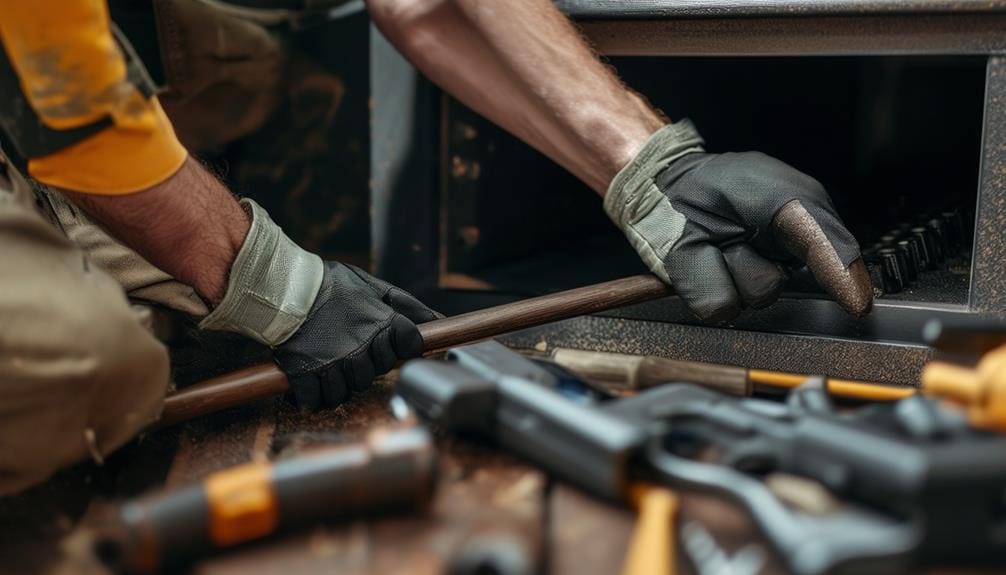
When prying open a gun safe, you need to understand the strategic positioning of door bolts and use gravity to your advantage. Start by examining the layout of the door bolts, which secure the door to the safe’s body. Knowing their position helps you apply force effectively with a pry bar.
First, insert wedges along the door’s perimeter. These wedges create an initial gap, allowing you to insert the pry bar. Make sure to position the pry bar near the door bolts, as this is where the door is most secure. By levering the pry bar while maintaining upward pressure, you can use gravity to help widen the gap further.
As you pry, gradually insert more wedges into the expanding gap. This step-by-step process ensures you distribute the force evenly, reducing the risk of damaging safe components. Remember, safe mechanisms are delicate, so precision is essential for damage prevention.
Always work slowly and methodically. Applying too much force can bend or break the door or its components. By understanding the interplay of the pry bar, wedges, door bolts, and gravity, you’ll improve your chances of opening the gun safe without causing irreversible damage.
Cutting Safes
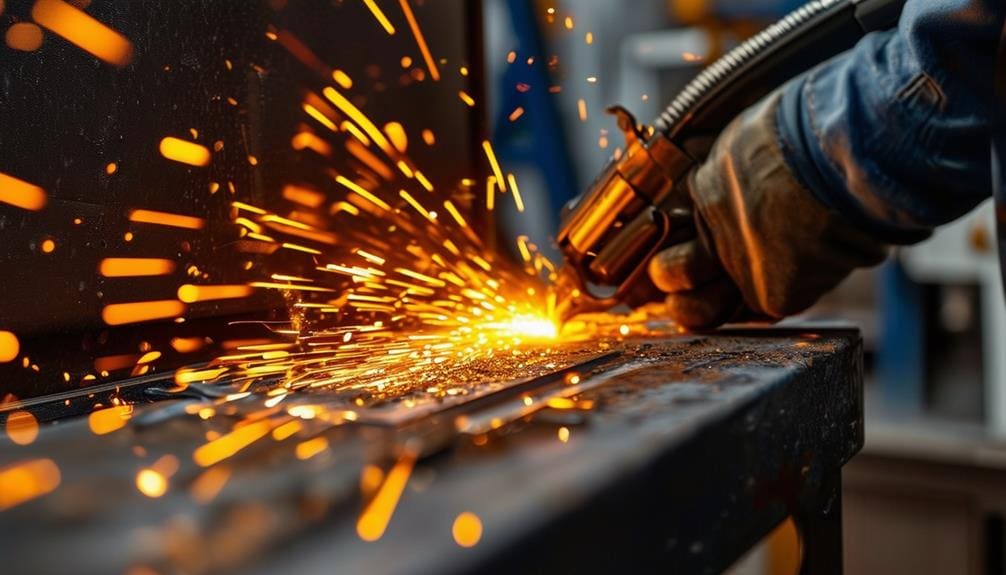
To cut into a gun safe, start by evaluating the safe’s construction and identifying the best point of entry, typically the walls rather than the heavily fortified door. First, check if the safe has cutting protection such as ceramic inserts. These can make torch-based cutting nearly impossible and require different techniques for cutting.
If the safe is free of such protection, use an angle grinder. Position the angle grinder on a wall of the safe, ensuring you avoid areas where valuables might be damaged. Always wear protective gear and work slowly to avoid overheating the metal, which could potentially compromise the contents inside.
In cases where cutting alone isn’t sufficient to open the safe, prying might be necessary. Use a sturdy pry bar in conjunction with your initial cuts to help gain access. Remember, using the right tools is essential for effectiveness and safety.
While cutting, always be mindful of any items inside the safe to prevent damaging valuables. By following these precise steps and employing the correct techniques for cutting, you can successfully gain access to a locked gun safe without unnecessary harm to its contents.
Preventive Measures
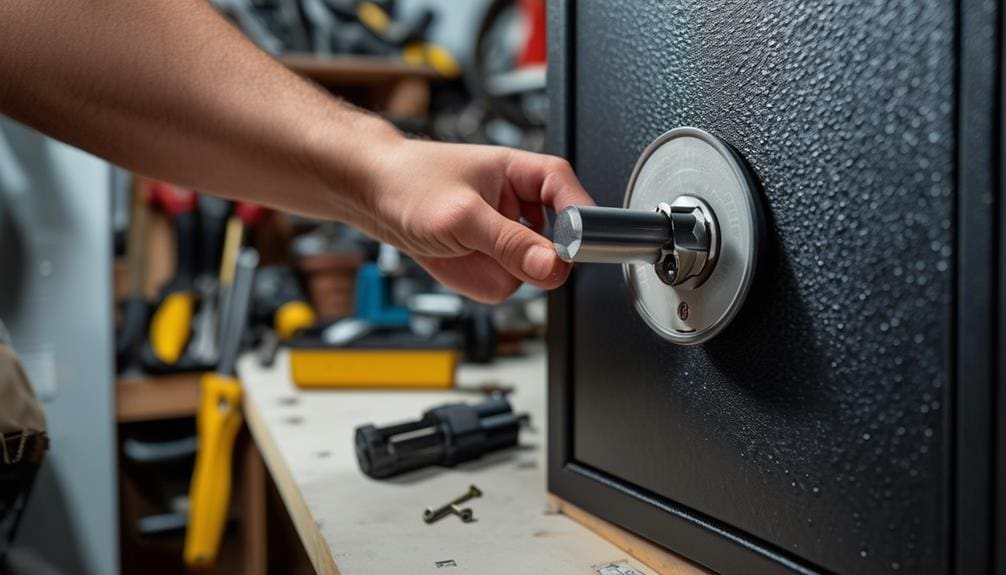
To prevent lockouts and guarantee your gun safe functions properly, establish a regular maintenance schedule every five years. Keep a secure record of your safe combination and create a backup key stored in a secure location. If issues arise, don’t hesitate to contact professional locksmith services for assistance.
Regular Maintenance Schedule
A regular maintenance schedule for your gun safe is important to secure its longevity and reliability. By following a strict servicing routine, you can prevent unexpected lockouts and confirm all components function smoothly. Start by scheduling regular maintenance every five years, or more frequently if your safe sees heavy use. This will help prevent wear and tear that could cause malfunctions.
First, keep a secure record of your safe’s combination and store a backup key in a secure place. This can be a lifesaver in case of a lockout. Regularly inspect the locking mechanism and hinges for any signs of wear or damage. Lubricate moving parts with a manufacturer-recommended lubricant to keep them operating efficiently.
If you encounter any issues, don’t hesitate to contact customer support. They can provide guidance on proper maintenance techniques and troubleshooting tips. For more complex problems, seek help from licensed professionals or locksmiths who specialize in safes. Their expert assistance can identify and fix issues before they lead to a lockout.
Backup Access Methods
Storing a backup key in a secure place outside of your gun safe is an important preventive measure to avoid the frustration of a lockout. It’s crucial to select a secure location that only you and trusted individuals know about. A backup key can be a lifesaver when electronic or mechanical failures hinder you from opening the safe.
Moreover, maintaining a written record of the safe combination in a separate, secure spot is vital. Be sure that this record is easily reachable but safeguarded from unauthorized access. This simple step can save you considerable trouble in the future.
Regular service of your safe, ideally every five years or as suggested by the manufacturer, is another fundamental preventive measure. Routine maintenance guarantees that the locking mechanisms and other components stay in optimal condition, reducing the chances of a lockout.
Develop a solid backup plan for lockouts prevention. This might involve reaching out to customer support for your safe brand or seeking assistance from licensed professionals. For instance, if you possess a Liberty safe, their customer support can offer valuable help.
Professional Locksmith Services
Hiring a skilled locksmith for preventive maintenance on your gun safe guarantees that the lock mechanisms stay in excellent condition, reducing the risk of future lockouts. Professional locksmith services provide expert handling of various types of gun safe locks and handle mechanisms. By opting for a licensed locksmith, you leverage their expertise to prevent damage during any necessary lockout resolution.
To safeguard your gun safe remains secure, follow these preventive measures. Regularly schedule maintenance with a licensed locksmith who can inspect the lock mechanisms for wear and tear. They will lubricate moving parts and validate that the handle mechanisms function smoothly, preventing potential lockouts.
If you face a lockout, a professional locksmith offers an efficient resolution. They use specialized tools and techniques to open the safe without causing damage, providing peace of mind and maintaining the integrity of your gun safe. Additionally, they can advise on advanced security measures and upgrades to further safeguard your firearms.
Incorporating professional locksmith services into your routine maintenance plan not only prevents future lockouts but also extends the lifespan of your safe. This proactive approach guarantees you always have access to your valuables while maintaining the highest level of security.
Professional Assistance
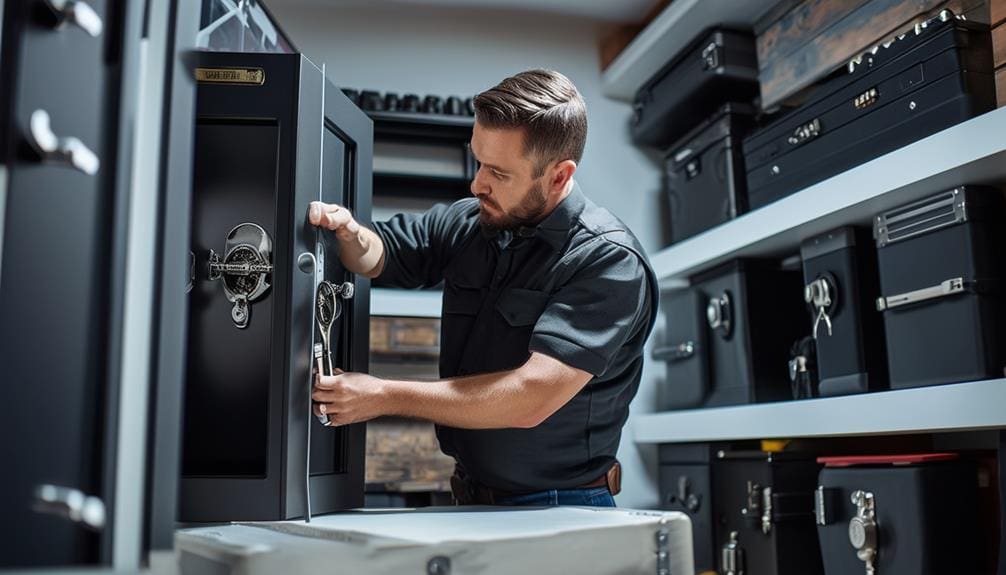
Seeking professional locksmith assistance is essential when you’re locked out of your gun safe to make sure it’s opened without damage. Experienced locksmiths have the expertise to handle various safe lockouts, offering efficient solutions without compromising the integrity of your safe. By enlisting professional assistance, you can avoid damage to your safe’s locking mechanism and its contents.
First, research and select an experienced locksmith specializing in safe opening. These professionals are trained to understand the intricacies of different locking systems and can provide effective solutions tailored to your specific safe. They use specialized tools and techniques to access safes, ensuring minimal disruption.
Additionally, expert locksmiths can offer advice on safe maintenance and security measures. Regular maintenance performed by a professional can extend the lifespan of your safe’s lock and enhance its security features. They’ll guide you on best practices to prevent future lockouts and keep your safe in optimal condition.
Consider the costs and benefits of hiring a locksmith. While it may involve an upfront expense, the investment ensures the safe opening is done correctly, preserving your safe’s functionality and security. When in doubt, consult expert tips from your locksmith for ongoing safe security.
Frequently Asked Questions
How to Open a Gun Safe Combo Lock?
To open a gun safe combo lock, try lock manipulation and combination recovery first. If those fail, consider safe drilling or using an electronic override for emergency access. For tricky situations, seek professional assistance or explore DIY solutions.
How Do I Open My Safe if I Forgot the Combination?
If you forgot your safe combination, try safe resetting options or contact the manufacturer. Safe cracking techniques like safe manipulation, safe drilling, or safe lock picking might help. Consider safe key replacement, override codes, or professional locksmith assistance.
Do Safes Have a Master Code?
Imagine a skeleton key for the digital age: yes, some safes have a master code. This safe technology enables emergency access, enhances safe security, and aids in safe maintenance. Contact the manufacturer for safe troubleshooting and access control.
How Do Locksmiths Open a Digital Safe?
Locksmiths open digital safes using advanced tools and locksmith techniques to exploit security vulnerabilities. They employ bypass methods, safe manipulation, and safe cracking, often resetting access control through digital technology, ensuring thorough safe maintenance afterward.
Conclusion
Opening a gun safe can be like solving a complex puzzle; each piece must fit perfectly. Whether you’re manipulating locks, drilling, or cutting, understanding the methods and preventive measures guarantees your safety and the security of your firearms. For best results, consult professionals when in doubt. By mastering these techniques, you’ll always have the right key to your safe, keeping your valuable assets protected and accessible when needed.

